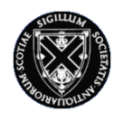Scottish Archaeological Internet Reports (SAIR)
Society of Antiquaries of Scotland, 2012. (updated 2023) https://doi.org/10.5284/1017938. How to cite using this DOI
Data copyright © Society of Antiquaries of Scotland unless otherwise stated
This work is licensed under the ADS Terms of Use and Access.
Primary contact
Society of Antiquaries of Scotland
National Museums Scotland
Chambers Street
Edinburgh
EH1 1JF
Scotland
Resource identifiers
- ADS Collection: 310
- DOI:https://doi.org/10.5284/1017938
- How to cite using this DOI
Excavation of an urned cremation burial of the Bronze Age, Glennan, Argyll and Bute
MacGregor, Gavin
with contributions by Michael Donnelly, Jennifer Miller and Julie Roberts and illustrations by Gary Tompsett and Caitlin Evans
Scottish Archaeological Internet Reports 8 (2003)
0903903776
Abstract: As part of the Historic Scotland Human Remains Call Off Contract, Glasgow Univ ersity Archaeological Research Division (GUARD)undertook an archaeological excavation of a prehistoric urned cremation deposit within a boulder shelter at Glennan, Kilmartin, Argyll and Bute (NGR NM86220097). Analysis has shown the cremation was of a male probably aged between 25 and 40 years. He had suffered from slight spinal joint disease, and mild iron deficiency anaemia, though neither seems likely to have affected his general health. He was cremated shortly after death, together with a young sheep/goat, and their remains were subsequently picked from the pyre and co-mingled before burial in the urn. An unburnt retouched flint flake was recovered which may have accompanied the burial. The closest parallels for the cremation container are found within the tradition of Enlarged Food Vessel urns, a tradition that is poorly dated but probably has a currency in the first half of the second millennium BC. Radiocarbon dating was problematic: a sample of heather-type charcoal from the fill of the urn was dated and provided a range of cal AD1260-1390 at 2 sigma (OxA-10281). A second date was obtained from a sample of hazel charcoal from the lowest part of the fill of the urn, which provided a range of 3370-2920 cal BC at 2 sigma (GU-9598). There are sufficient examples of animal bone previously found accompanying Bronze Age burials to suggest that animals may have had a role in mortuary rites before burial of human remains, though the role and status of these animal remains is not always clear. Although the sample is small, the evidence suggests that, depending on the burial rite, some species of animals were considered more appropriate than others for inclusion; pigs associated with inhumation and goat/sheep associated with cremation burials. The choice of a domesticated animal to accompany the mortuary rites may have been of significance during a period when agro-pastural farming was being widely practiced, and may reflect the perceived inter-relationship between the cultural landscape of people and their livestock. The context of deposition of an Enlarged Food Vessel urn at Glennan, in a boulder shelter in the uplands, provides an interesting contrast with the known deposition of Food Vessels focused on the valley floor at Kilmartin. It indicates that while many of the more visible ceremonial and funerary sites of the second millennium BC may focus on the floor of the glen, other parts of the landscape were also significant in terms of such activities.
POSTSCRIPT The cremated bone from the Glennan urn, that had previously given some problematic dates (Report Section 8) has now (March 2004) produced a result of 3615+/-35BP (GrA-24861). At 2130-1880 calBC (2-sigma), this is well within the range of dates for such Vase Urns. The author of SAIR 8 acknowledges the Society of Antiquaries of Scotland for funding this radiocarbon date and the National Museums of Scotland Dating Cremated Bone Project (especially Dr Alison Sheridan) for organising it.
Download report
| Scottish Archaeological Internet Report 8 | 362 Kb |







